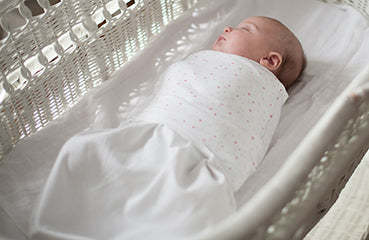We hear many parents ask “What is Moro reflex (also known as startle reflex) in infants?” If you have heard of swaddling, then there is a good chance that you have also heard about Moro reflex.
If not, then keep reading, we will give you the skinny on Moro reflex, which all infants have at birth. We will go over what it is, why it occurs, when it starts, why you should care, how swaddling helps and when it typically ends.
Identifying Moro reflex
When the Moro reflex is evoked, the baby has a two phase reaction:
Phase 1 - The baby will experience what can be best described as a sensation of free-falling where the baby reacts by lifting and stretching their arms and may even let out a gasp of air.
Phase 2 - The baby will curl the arms and legs closer to their body into a slight fetal position.

Moro Reflex Video courtesy, Klaus-Dieter Keller
This can be particularly troublesome during sleep time, which we will touch on in a bit.
Why Does Moro Reflex Occur?
Would you believe that the Moro reflex is present to protect your newborn in these early stages of development? As a newborn is unaware of cause and effect yet, this reflex acts as an alarm that is triggered when a baby receives excessive or sudden information via the senses.
The first phase of the response (as described in the previous section) helps the baby react to an unpleasant stimuli. The second phase helps them cling to whatever is close, such as their mother, as a way to protect themselves from falling.
These two responses instinctively protect a child from whatever danger is associated with the stimulant. This is described in detail in this article.
At birth all babies have a nervous system that is still developing. One sign of their developing nervous system is that until 4 - 6 months of age infants startle easily as they experience a whole new world of sensations that was absent in the womb.
Triggers of Moro Reflex
Moro reflex is triggered by any sudden changes in sensual stimulation. There are many such triggers, but the major ones are:
1) A loud noise.
2) A sudden touch.
3) An abrupt change in the intensity of light.
4) Any event that puts the baby off balance - such as a drop in altitude (when being placed into a crib, for example) or a tilt in direction of his or her body.
Absence of Moro Reflex or Startle Reflex
The absence of the Moro reflex, either on one or both sides, may signify problems in a baby’s nervous system. This can be checked and addressed by your pediatrician during scheduled visits. Should you see an absence of this reflex in between visits, you should bring it to your pediatrician’s attention immediately.
At birth your pediatrician checks for the Moro reflex among many other reflexes your baby is born with. See how this reflex is checked in this article by MedilinePlus, a National HealthCare Library.
If you are curious about what other reflexes your developing baby is born with, visit this article by U.S. National Library of Medicine detailing the different types of newborn reflexes.
Why Should You Should Care About the Presence of the Moro Reflex?
If the presence of Moro reflex is normal, even essential, then why should you care about it? Well, when babies startle they also flail and cry inconsolably. This is particularly disruptive if it happens during naps or bedtime.
A perfectly calm sleeping baby can wake up and take time to fall back asleep thus disrupting your schedule as well.
How to Calm a Baby Experiencing Moro Reflex?
It has been found that babies experiencing Moro reflex will calm down easily if their stretched arms and legs are drawn closer to their bodies and held in place until they calm down.
This is where swaddling comes in. A swaddle is a fabric that wraps around baby’s body to hold their arms and legs closer to their body thus keeping them from flailing and waking during incidents of Moro reflex.

Other Benefits of Swaddling
A swaddle also helps create a snug environment that babies were used to before birth, in the womb. See this page on how to swaddle with our super easy to use Zen Swaddle to find one of the techniques on how to swaddle like a pro and keep baby safe while doing so. For more info on other benefits of swaddling, check out our learn page here.

How Long Does the Moro Reflex Last?
Typically by week 6 you should see the neck muscles of your baby get stronger and their overall balance and ability to support themselves starting to improve. This is the beginning of the improvement of Moro reflex.
By month 4 - 6, signs of Moro reflex are completely gone. This is also when your baby has more control over his/her movements and can roll over and back. If you are still swaddling, this is the right time to start transitioning over to a sleeping bag.
Visit our blog on when to stop swaddling to learn more about when it's time to graduate out of the swaddle. If you are already sure it's time to drop the swaddle, check out our step by step swaddle transition plan to help with the move.

